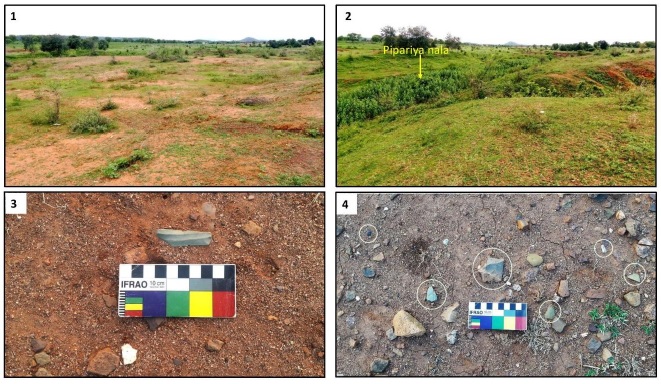Newly Discovered Prehistoric Sites in the Seonath Basin, Chhattisgarh, India
DOI:
https://doi.org/10.54741/ssjar.3.4.8Keywords:
prehistory, palaeolithic, microlithic, seonath river, chhattisgarhAbstract
Prehistoric cultures shed light on the evolution of human social organization. The development and use of stone tools are significant milestones in human evolution. Prehistoric artifacts provide evidence of early technologies and the progression of tool-making techniques. Presented paper provides a comprehensive overview of the recently identified Prehistoric sites within the Durg and Rajnandgaon districts situated in the Central Seonath Basin of Chhattisgarh. It offers detailed descriptive and contextual data regarding these newly discovered archaeological locations. The discussed sites or site complexes include Palaeolithic, microlithic and individual artifacts finding sites along the Durg-Raipur upland, Rajnandgaon upland and Eastern edge of the Mekal range in Rajnandgaon district. The occurrences vary in terms of their locations, scatters, context and tools typology.
Downloads
References
Das, N., Ganguly, M., & Chatterjee, N. (1991). Geology of dhamdha – Nandiny area durg district madhya pradesh. Raipur: Geological Survey of India.
Joshi, R. V., Badam, G. L., & Pandey, R. P. (1980). Exploration in district Bilaspur and Raipur. (B. K. Thapar, ed.) Indian Archaeology 1977-78 - A Review, 31.
Mishra, S., Chauhan, N., & Singhvi, A. K. (2013). Continuity of microblade technology in the Indian subcontinent since 45 ka: Implications for the dispersal of modern humans. Plaos One, 8(7), 1-14. https://doi.org/10.1371/journal.pone.0069280.
Ota, S. B., & Deo, S G. (2014). Investigation of acheulean localities TKD-I and TKD-II at tikoda, district raisen, madhya pradesh(2010-2012). (K. Paddayya, & S. G. Deo, Eds.) Recent Advances in Acheulean culture studies in India, ISPQS Monograph No. 6, 55-66.
Paddayya, K., Blackwell, B., Jhaldiyal, R., Petraglia, M. D., Fevrier, S., Chanderton, D., . . . Skinner, A. (2002). Recent findings on the acheulian of the hunsgi and baichbal valleys, karnataka, with special reference to the isampur excavation and its dating. Current Science, 83(5), 641-657.
Pandey, R. P. (1982). Archaeology of the upper mahanadi valley madhya pradesh India. Unpublished Ph.D. Thesis. Deccan College Post Graduate and Research Institute, Pune, India.
Pappu, R. S. (2001). Acheulian culture in penisular India: An ecological perspective. New Delhi: D.K. Printworld.
Pappu, S., Gunnell, Y., Akhilesh , K., Bracuher, R., Taieb, M., Demory, F., & Thouveny, N. (2011). Early pleistocene presence of acheulean hominins in South India. Science, 331, 1596-1599.
Pradhan, A., & Yadav, S. (2013). Chhattisgarh ka pragaitihasik adhyayan- Ek punravlokan (in Hindi). Kosal, 6, 34-43.
Rao, L., Yadav, C., & Dogra , P. (1997). Exploration in district rajnandgaon. (A. Shankar, Ed.) Indian Archaeology 1992-93 - A Review, 55.
Sahu, V. (2017). Balodabazar-Bhatapara jile me naveen anveshit pragaitihasik kalin pashan upkaran (in Hindi). Kosal, 10, 154-156.
Sharma, A. K., Ota , S. B., Dubey, J. S., Dwivedi, R. K., Nimje, N. K., Yadav, C. L., & Dogra, P. C. (1995). Exploration in district durg. (S. K. Mahapatra, Ed.) Indian Archaeology 1990-91 - A Review, 39-40.

Downloads
Published
How to Cite
Issue
Section
ARK
License
Copyright (c) 2023 Lalita Lahari, Hemant Kumar Vaishnav, Janardhana B

This work is licensed under a Creative Commons Attribution 4.0 International License.
Research Articles in 'Social Science Journal for Advanced Research' are Open Access articles published under the Creative Commons CC BY License Creative Commons Attribution 4.0 International License http://creativecommons.org/licenses/by/4.0/. This license allows you to share – copy and redistribute the material in any medium or format. Adapt – remix, transform, and build upon the material for any purpose, even commercially.










